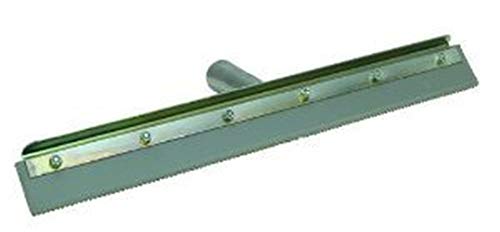If you are a construction professional or a DIY enthusiast, then you probably know the value of a good plastering trowel. However, over time, these tools can become rusty, making them less effective and more difficult to work with. Rust not only affects the appearance of your trowel, but it can also transfer to the surface you are working on, leading to unsightly stains on your plaster. Therefore, it’s essential to know how to remove rust from your plastering trowel and restore it to its former glory.
One effective method to remove rust from a plastering trowel is by using vinegar. Vinegar is a mild acid that can dissolve rust without causing damage to the metal surface. Start by soaking the rusted areas of your trowel in a bowl filled with vinegar for at least 1-2 hours. After the soaking period, use a scrub brush or an abrasive pad to scrub away the rust. Make sure to apply pressure while scrubbing to remove any stubborn rust spots.
If vinegar alone doesn’t do the trick, you can try using a mixture of vinegar and baking soda. Create a paste by combining equal parts of vinegar and baking soda. Apply the paste to the rusted areas of your trowel and let it sit for about 15-20 minutes. Then, use a scrub brush or an abrasive pad to scrub away the rust. The combination of vinegar and baking soda creates a reaction that helps to loosen and dissolve the rust.
Once you have successfully removed the rust from your plastering trowel, make sure to thoroughly rinse it with clean water to remove any vinegar or baking soda residue. After rinsing, dry the trowel with a cloth or towel to prevent any new rust from forming. To further protect your trowel from rust, it’s advisable to apply a thin coat of oil or a rust inhibitor. This will create a barrier that prevents moisture from reaching the metal surface and causing rust.
By following these simple steps, you can effectively remove rust from your plastering trowel and ensure its longevity. Remember to regularly inspect and clean your trowel to prevent rust from forming in the first place. A well-maintained trowel will not only make your plastering job easier but will also contribute to the quality of your work.
Why Rust on Plastering Trowel is a Problem
Rust on a plastering trowel is not only unsightly but can also affect the quality of your plastering work. Here are a few reasons why rust on a plastering trowel is a problem:
1. Reduced Performance: Rust on the surface of a plastering trowel can affect its smoothness and reduce its overall performance. The rust can create rough patches on the blade, making it difficult to achieve a smooth finish on the plastered surface.
2. Poor Quality Finish: When using a rusty plastering trowel, the rust particles can mix with the plaster, causing small blemishes and imperfections on the surface. This can result in a poor quality finish that is not visually appealing.
3. Impaired Durability: Rust weakens the structural integrity of the trowel and can lead to premature wear and tear. Over time, the rust can cause the blade to weaken and eventually break, rendering the trowel unusable.
4. Contamination: Rust particles that mix with the plaster can contaminate the entire batch, affecting the quality and consistency of the plaster. This can lead to uneven drying and curing, resulting in a compromised final product.
5. Health and Safety Concerns: Rust can create sharp edges and protrusions on the trowel blade, increasing the risk of cuts and injuries during use. Additionally, inhaling rust particles can cause respiratory issues and other health problems.
To ensure high-quality plastering work and maintain the longevity of your plastering trowel, it is important to regularly remove any rust and keep it clean and dry.
How Rust Affects Performance
Rust can have a significant impact on the performance of a plastering trowel. When rust begins to form on the surface of a trowel, it can create imperfections and rough spots that affect its ability to smoothly spread plaster. These imperfections can cause the plaster to stick to the trowel, making it difficult to apply an even coat.
In addition to affecting the smoothness of the plaster application, rust can also weaken the structural integrity of the trowel. As rust eats away at the metal, it can cause the trowel to become thinner and more prone to bending or breaking. This can compromise the functionality and durability of the tool.
Rust can also lead to the formation of rust particles or flakes that can become embedded in the plaster. These particles can create blemishes and roughness in the finished surface, detracting from the overall quality of the plaster job.
Furthermore, rust can contribute to the corrosion of other metal tools or materials used in the plastering process. If a rusted trowel comes into contact with other tools or materials, it can transfer rust particles or accelerate the rusting process, leading to further damage.
To ensure optimal performance and longevity of a plastering trowel, it is important to regularly remove any rust and keep the tool clean and well-maintained. Removing rust from a trowel can be done using various methods, such as scrubbing with a wire brush, soaking in vinegar, or using commercial rust removers. Taking preventive measures, such as drying the trowel after each use and storing it in a dry area, can also help to minimize the risk of rust formation.
Steps to Remove Rust
If you have a rusted plastering trowel, it’s important to remove the rust to keep it functioning properly. Here are the steps to safely remove rust from your plastering trowel:
Step 1: Prepare the Materials
Gather the necessary materials for the rust removal process. You will need:
| – White vinegar | – Steel wool or a wire brush | – Clean cloth or paper towel |
Step 2: Remove Loose Rust
Use a steel wool or wire brush to scrub away any loose rust on the plastering trowel. Apply gentle pressure and work in small circular motions. Make sure to cover all affected areas.
Step 3: Soak in Vinegar
Pour white vinegar into a container large enough to submerge the plastering trowel completely. Place the trowel in the vinegar and let it soak for about 24 hours. The acidity of the vinegar will help break down the rust.
Step 4: Scrub Again
After soaking, remove the plastering trowel from the vinegar and scrub it again with steel wool or a wire brush. This will help remove any remaining rust that may have loosened during the soaking process.
Step 5: Rinse and Dry
Rinse the plastering trowel with clean water to remove any vinegar residue. Dry it thoroughly with a clean cloth or paper towel. Make sure there is no moisture left on the trowel, as this can lead to further rusting.
Following these steps will help you effectively remove rust from your plastering trowel, allowing you to continue using it for your projects with ease.
Preventing Rust from Forming
Rust on a plastering trowel can significantly affect its performance and durability. To prevent rust from forming on your trowel, follow these essential steps:
1. Clean and Dry Properly
After using your plastering trowel, it is crucial to clean it thoroughly to remove any debris, plaster, or other substances that may promote rust formation. Use warm soapy water and a sponge or soft cloth to scrub the trowel gently. Rinse it with clean water and dry it completely before storing it.
Pro tip: By keeping your trowel dry, you can prevent moisture from accumulating and causing rust.
2. Apply a Protective Coating
Protective coatings, such as oil or wax, can provide an extra layer of defense against rust formation. Apply a thin coat of the chosen protective substance onto the trowel before storing it. Make sure to cover all metal surfaces evenly. This coating will act as a barrier, preventing moisture and air from reaching the metal and causing rust.
Pro tip: Reapply the protective coating periodically, especially if you use the trowel frequently or if it is exposed to a humid environment.
Note: Be cautious not to apply too much coating, as it may affect the trowel’s performance.
By following these preventive measures, you can significantly reduce the risk of rust forming on your plastering trowel. Remember to clean and dry the tool properly after use and apply a protective coating regularly for optimal results.
Maintenance Tips for Plastering Trowels
Plastering trowels are essential tools for any plasterer and it is important to keep them in good condition for optimal performance. Here are some maintenance tips to help you keep your plastering trowels rust-free and in top shape:
1. Clean after each use: After using the trowel, make sure to remove any excess plaster or debris. Use a stiff brush or scraper to gently clean the surface and edges of the trowel. This will prevent the accumulation of hardened plaster that can lead to rust formation.
2. Remove rust: If you notice rust spots on your trowel, it is important to remove them as soon as possible. Use fine-grit sandpaper or a wire brush to gently scrub away the rust. Be careful not to damage the blade or handle of the trowel while doing this.
3. Apply a rust preventive coating: To prevent rust from forming on your plastering trowel, consider applying a rust preventive coating. There are various rust preventive sprays or oils available in the market specifically designed for this purpose. Follow the manufacturer’s instructions to apply the coating evenly on the surface of the trowel.
4. Store in a dry place: Moisture is the main enemy of plastering trowels as it can promote rust formation. After cleaning and applying a rust preventive coating, make sure to store your trowel in a dry place. Avoid leaving it exposed to damp conditions or water. Consider using a tool bag or a dedicated storage area to protect your trowel from moisture.
5. Regular inspection: Make it a habit to inspect your plastering trowel regularly for any signs of wear, damage, or rust. Pay attention to the blade, handle, and any other parts of the trowel. If you notice any issues, address them promptly to prevent further damage or deterioration.
By following these maintenance tips, you can extend the lifespan of your plastering trowels and ensure they perform optimally for your plastering projects. Remember, a well-maintained trowel is a reliable tool that helps you achieve smooth and professional plastering results.






